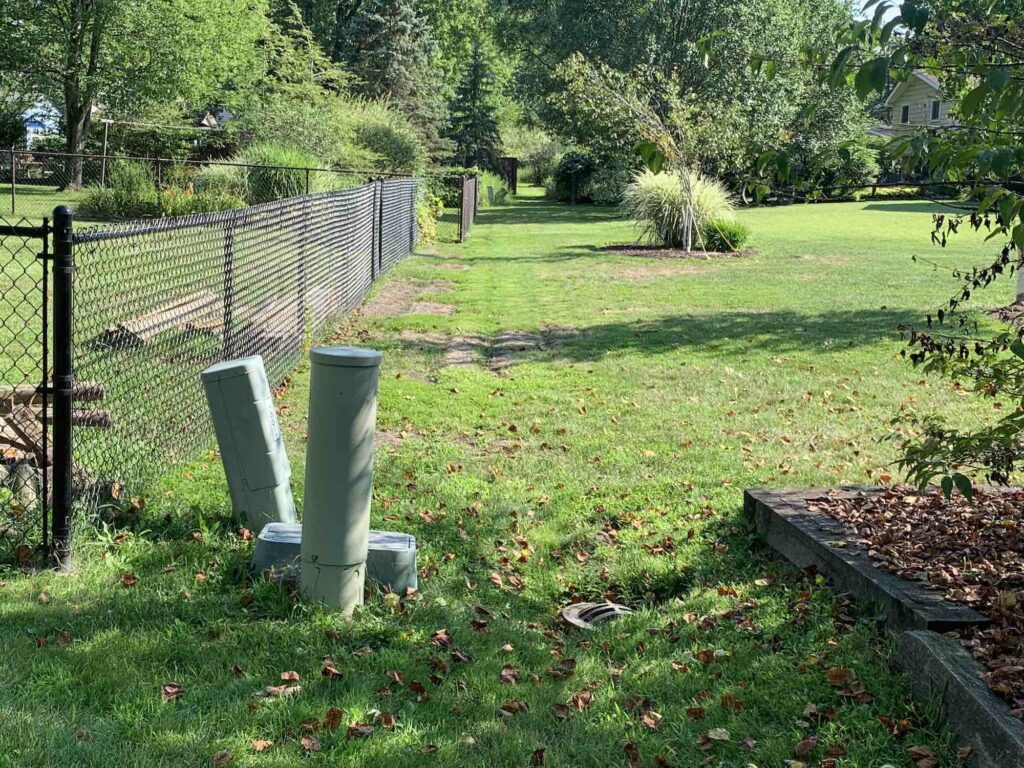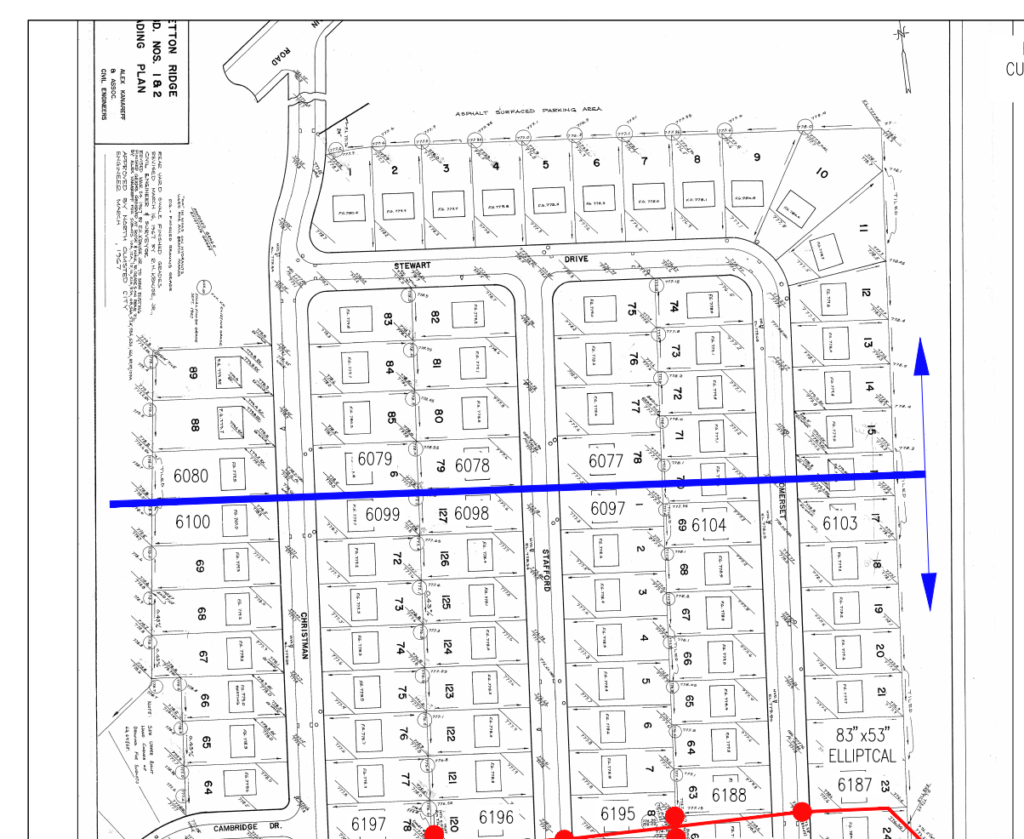Many of the items contained in this post are likely common knowledge. But as a point of reference, I think it’s important occasionally to review the expectations for homeowners, the HOA board, and the expectations for the city, and where the demarcation line may be. With that in mind, let’s take a look at a few of the areas around your home that may be causing water or related issues, and look at who might be responsible for the maintenance and upkeep of each.
Again as a frame of reference, attached to this post is a map of the north side of Bretton Ridge, property demarcation lines, and arrows that indicate grading and flow for each property in the development. On the maps, you may need to zoom in, you’ll see very thin Arrows with long points. Maps of the south side of the development have been difficult to track down. (New/updated drainage maps of the south side of BR may need to be recreated based on the work being done by city crews this year.) Those will point in the direction the water is supposed to flow away from your house in towards either a backyard drain, or the street. And either case, they should give you some idea of how your landscaping should be graded, based on how the yards were originally planned by the developer.
It is also possible that over the years, certain areas of your yard, especially property lines in the backyard, have been taken over by fences and landscaping obscuring the graded swale. The swale, or what some people might call an easement, may be part of a backyard drainage issue. Without regulation of property lines by fence installers and other property owners, what was once a drainage swale might now be a fence line. Keep in mind that I am not proposing that people start tearing down fences, but if you have backyard drainage issues, obstructed swales – that lead to drains – may be part of the issue.
Technically, the areas in between property lines in the backyard should have 3 feet of space between any fences. Fences should not be built directly on the property line. However, over the years, without any kind of regulation, it’s common to see yards and yards worth of fence placed directly on the property line obstructing the swale. It’s not likely that much can be done about moving fences, but if there’s a natural border of landscaping or grading, it may be possible to adjust the grading to benefit a group of neighbors that share a common backyard drain – allowing the natural flow of water to be unobstructed to the drain.
It has never been in the business of the Bretton Ridge HOA to police these kinds of things, and it’s not my intention to do so now. So please use this information to inform yourself, and work with your neighbors to address any issues in backyard drainage that you might be experiencing collectively.
STREET DRAINS
Drains under the street are the primarily the responsibility of the city. They are responsible for maintaining both the storm and sanitary systems. The city can be contacted to investigate potential blockages, or cracked pipes within their system. They have also been very generous in helping homeowners clean out the lateral lines from the street up to a certain point on your property. They will not, however, go beyond the exterior of your house. If you have an issue with any of the street drains in your area, you can contact the service department directly to get an answer to your questions or service requests.
It’s also important to remember as an individual homeowner, you can do your part to keep debris out of the drains. For example, when you rake and blow leaves in the fall, leaves need to stay on your tree lawn, and not in the street. Or, when you cut grass, make sure that grass clippings do not end up in the street. Either one of these would likely end up washing into the storm system, taking up space or blocking access for stormwater. Same is true for ice and snow melt.
When the city crews did maintenance on the drains and Bretton Ridge over the last few months, they reported that there were generally three main items they removed from the drains; sticks and leaves, grass clippings, and asphalt debris from roofs and the street.
Homeowners are the first line of defense in making sure that the street drains are clear of sticks and debris at the surface level. You can always work with your neighbors to walk the street in your area to make sure that those street drains are clear!
BACKYARD DRAINS
This is a mixed answer. Since stormwater drainage is a city responsibility, generally the city will help to make sure that the drain line from the street to the backyard is open and functioning. They will also help homeowners locate the drain in the backyard, if it still exists. However, once the drain has been located, and verified as functional, it is up to the individual homeowner to make sure that that train is maintained, and is free of debris.

That being said, the city of North Olmsted will help individual homeowners locate the backyard drain closest to their house. It may require some coordination between neighbors to locate the drain and to test it. For example, the drain closest to my backyard was located in my neighbor’s yard, buried under mulch. We had to work together with the city to get proper access to the yard, then find and uncover the drain. Using the map of backyard drains found here: https://drive.google.com/file/d/1b0SulMIMiwD3tkY_wbQOvft4Ty-URBIo/view?usp=sharing and here: https://drive.google.com/file/d/1G-jH5-b4oDD34-FKDmkXHC4B-QEg-dGp/view?usp=sharing it is important to also note the direction of flow from the yard drain to the street. In some cases, the yard drain will be connected to the street opposite your own. Still, uncovering the drain, and verifying the flow will benefit everyone.
In a future post exclusively covering backyard drains, I’ll use my house as an example of ways in which homeowners can work together to find a solution to the backyard flooding problems they may be experiencing. One solution involves the drain, and another involves adding a crock and pump in a space where a drain isn’t available, but where flooding might happen. The city is willing to help homeowners establish a new connection to the main storm line if they are interested in that type of solution. Look out for that post coming soon.
Solving your backyard drainage issue may be related to your basement issues. For example, when your sump pump is working hard to push water out of your house, it may be headed to the backyard. If your backyard is already flooded, that water is gradually seeping back through the ground, against your foundation, into the weeping system, into your basement crock, and then gets pumped out again. Creating a cycle of futility. If your backyard drainage gets resolved, it will naturally take water pressure off of your foundation, and your sump pump, and will lessen the possibility that these systems will become overwhelmed by volume and or pressure.

If a drain is not available close to your home, the city has confirmed that they will help to install a new connection at the street, if homeowners are interested in adding something to their own yard. Homeowners could work together on a project like this that might serve several homes having the same issue – sharing in the solution – with a new connection at the street.
GUTTERS AND DOWNSPOUTS
Simply put, these are your responsibility as the homeowner. It’s always a good idea to keep these clean and clear of debris as much as possible. There are plenty of services or handymen (or women) around willing to give you help with this project. Additionally, if you feel that your basement walls and weeping tiles may be overwhelmed by the volume of water coming through your gutters and downspouts, it may be a good idea to have someone take a look at your system to see if diverting some of that water to the street or yard may help. Rain Barrels, garden retention, or diverters to the street may be options to consider as a homeowner. There are lots of options to consider, but the most important is to make sure these systems are free of leaves and debris that might find there way to the city system causing larger issues in the community.
LATERAL LINES
This is a mixed answer again. Remember, there are two systems underground; the storm and the sanitary. Both of these systems run ‘lateral’ lines from your house to the street where wastewater or stormwater is evacuated. Occasionally, these lateral lines can become blocked or reduced in volume, which could cause problems. The city will help to make sure that your lateral lines are clear from the street side. They will come out to help inspect these lines, and clear out debris from the street side. You as the homeowner have to take care of the other side. A plumber will have the tools and equipment to enter the lateral line from the cleanout inside your house, and will be able to jet or snake the lines clear. They will clear the lines from inside the house at the main stack cleanout, all the way to the street. Often these laterals are blocked by items that get flushed that shouldn’t be flushed, and may build up over time causing problems.
*Having your lateral lines cleaned was the #1 recommendation by the city workers. If you experience slow drains, you may want to consider having this done. It’s recommended to do this every few years to keep the lines clear.
BASEMENT OR OTHER INTERIOR
Anything inside your house is the responsibility of the homeowner. The city will not enter your home to diagnose or solve problems. When considering having work done, be sure to get multiple opinions and estimates, and always ask the contractor to explain why their proposal will solve your problem.
YARD SWALE
The city will not maintain the swale between houses in Bretton Ridge. The closest they will come to any kind of maintenance is to assist homeowners in finding backyard drains. The rest is up to you and the neighbors in your area to maintain. This is tricky, as so many of the natural swale areas have been built up, covered over, or fenced in around Bretton Ridge. When the development was built, between each back yard was a 3 foot ‘easement’ where utility lines like tv or internet were run. In many places these boxes still exist and are serviceable by internet companies.

Ultimately, the swale, sometimes referred to as an easement (though it is not actually an easement), is the responsibility of the homeowners. In the ‘best case’ scenario, you ‘should’ be able to see from one end of the street to the other down the swale between yards. Now, this is rarely the case due to fences, trees, brush, or other obstructions placed directly on or through the property line. Homeowners who experience backyard flooding or drainage issues should try to coordinate with their neighbors to make sure that water is able to flow toward the common drain found on the maps above, and the passage to that drain is free of major obstacles like trees, dramatic grade changes, patios, sheds or similar. Again, this is a really tough problem to solve, especially when it comes to working with neighbors you don’t know or don’t get along with.
This is a difficult problem to remedy, and may not be possible to ‘fix’ in certain areas of the neighborhood. It can be said, however, that it is definitively a problem that resides with the homeowner and neighbors and not with the city or HOA.

